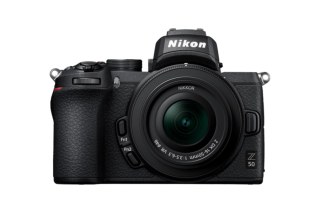Nikon Z 50
Tiny has never been a bigger deal for Nikon

Nikon has announced the new 20MP Z50 mirrorless camera: the first time the company has put an (unstabilized) APS-C sensor behind its new, larger 'Z' lens mount. It’s a camera that’s smaller, lighter, and cheaper than its full-frame siblings. The company says the camera is designed to attract a generation of users who don't consider themselves to be aspiring photographers.
Despite being Nikon's first APS-C mirrorless camera, a lot of the features are familiar: the user interface has been lifted directly from the full-frame Z cameras, the sensor is a variant of the one in the D500 and D7500, built into a camera that's conceptually similar to the entry-level DX-Format D5600.
The version of the Z50's sensor has a series of stacked masks in front of the sensor, meaning that some pixels only receive light from one or the other side of the lens. The data from these masked pixels allows the differences between the image entering the left and right-hand-side of the lens to be compared, which is then used to assess depth in the scene, thus improving the 'phase-detection' autofocus system.
Autofocusing is achieved through a 209-point Hybrid AF system that boasts Nikon’s Eye Detection AF feature (the first time it has appeared in a DX-format camera). The AF points span about 87& of the frame horizontally and 85% of the frame vertically.
Inside the 14oz (~0.4kg) magnesium-alloy-framed Nikon Z50 camera is a 20.9-megapixel DX-format CMOS sensor backed by an EXPEED 6 image-processing engine. The camera has a native ISO of up to 51200 — the highest standard sensitivity of its class — and up to 11fps continuous shooting.
Appearance
The Nikon's Z50 looks like a scaled-down Z6, with a prominent viewfinder hump protruding from the middle of the camera and a handgrip extending forward from the body, without it ever looking like a masked DSLR.
The Z-mount is oversized, even for a full-frame format, which means that the Z50 isn't much smaller than its big sensor brothers Z6 and Z7, but the lack of top-plate LCD immediately sets them apart visually. The build quality seems similar to Z6 and Z7, although Nikon describes the camera as weather-sealed only.
Electronic Viewfinder
The Z50 uses a 2.36M-dot OLED viewfinder — pretty much standard for a camera of this price.
The optics in front of the OLED viewfinder panel are designed in-house by Nikon, as a way of emphasizing its optical know-how. And, sure enough, they offer a good view of the screen with little apparent distortion and a reasonable 1.02x magnification ratio (0.68x full-frame equivalent). At 20mm, the eye-point is a little short for some glasses wearers to see the extreme corners of the screen, but it's significantly bigger than the one in the entry-level D5600, which only managed 0.82x magnification and 95% coverage.
The touchscreen
The Z50 has a rear touchscreen that folds out and up by 90 degrees, extending outwards so that a downwards view to it isn't obscured by the viewfinder's rearward projection.
The touchscreen also tilts downwards, again extending outwards a fraction from the body in order to let it flip down a full 180 degrees, to point forward, below the camera. This opens up some possibility of selfies and video blogging. The camera can capture 4K video, 120p slow-motion, and time-lapses (with the built-in intervalometer). Videos can also be trimmed in-camera.
The Z Series DX Lenses
Alongside the camera, Nikon has announced two lenses designed for this sensor size: Z DX 16-50mm F3.5-6.3 collapsible standard zoom and a Z DX 50-250mm F4.5-6.3 telephoto zoom - both with built-in image stabilization (which Nikon calls Vibration Reduction).
The lenses are ultra-compact with a 16mm flange focal distance, have reduced focus breathing, offer a customizable control ring (for smooth aperture or exposure compensation control), and both offer built-in optical Vibration Reduction (VR) with 4.5 stops and 5.0 stops of compensation (respectively).
Price and Availability
The Z50 will be available from November 2019 for $860 (body only) — by comparison - Z6 is $1,800 as of summer 2019. It’ll also be available for $1,000 with the Z DX 16-50mm included and $1,350 with both the Z DX 16-50mm and 50-250mm lenses bundled.
The Z DX 16-50mm f/3.5-6.3 VR and Z DX 50-250mm f/4.5-6.3 VR lenses will also be available separately for $300 and $350, respectively.
Tech Specs
- Effective Pixels (Megapixels): 20.9 million
- Sensor Size: 23.5 mm x 15.7 mm
- Image Sensor Format: DX-Format
- Storage Media: SD (Secure Digital) and UHS-I compliant SDHC and SDXC memory cards
- Top Continuous Shooting Speed at Full Resolution: 11 frames per second
- ISO Sensitivity: ISO 100 - 51,200 in steps of 1/3 or 1/2 EV Can also be set to approx. 1 or 2 EV (ISO 204,800 equivalent) above ISO 51,200; auto ISO sensitivity control available
- Movie/Video/Film:
- 4K UHD 3,840 x 2,160 / 30 fps
- 4K UHD 3,840 x 2,160 / 25 fps
- 4K UHD 3,840 x 2,160 / 24 fps
- Full HD 1,920 x 1,080 / 120 fps
- Full HD 1,920 x 1,080 / 100 fps
- Full HD 1,920 x 1,080 / 60 fps
- Full HD 1,920 x 1,080 / 50 fps
- Full HD 1,920 x 1,080 / 30 fps
- Full HD 1,920 x 1,080 / 25 fps
- Full HD 1,920 x 1,080 / 24 fps
- Full HD 1,920 x 1,080 slow-mo / 30 fps x4
- Full HD 1,920 x 1,080 slow-mo / 25 fps x4
- Full HD 1,920 x 1,080 slow-mo / 24 fps x5
Actual frame rates for 120p, 100p, 60p, 50p, 30p, 25p, and 24p are 119.88, 100, 59.94, 50, 29.97, 25, and 23.976 fps respectively.
Quality selection available except at sizes of 3,840 x 2,160, 1,920 x 1,080 120p/100p, and 1920 x 1080 slow-motion or when U or 6 is selected in q mode, in which case quality is fixed at m (high).
